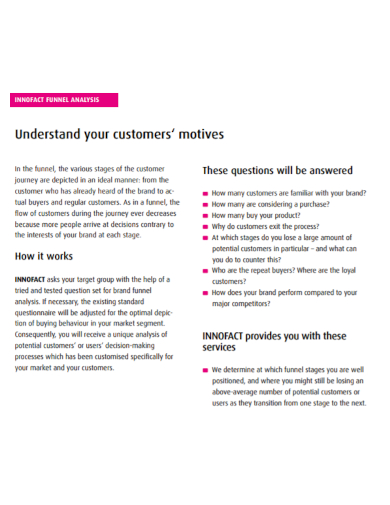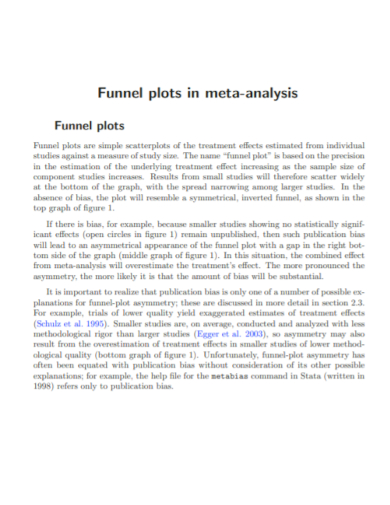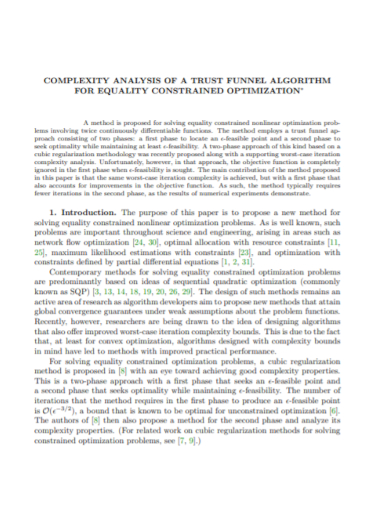3+ Funnel Analysis Samples
With the advent of technology, traditional businesses need to adapt (even shift) to the digital platform. It’s basically sink or swim. In online businesses, the sales approach is a bit different. You obviously want your prospects to come to your website, learn about what you do, go over the price information, and then convert – make a purchase, fill out a form, or sign up for your newsletters. It’s not easy to establish a funnel analysis. To get it correctly, it requires a lot of thought. You should examine the path your visitors are traveling as well as the types of material that are helping to shape the customer journey. In this article, we provide you with free and ready-to-use samples of Funnel Analysis that you could use in order to give you more traffic and engagement insight for your website. Keep on reading to find out more.
1. Funnel Analysis
2. Funnel Plots Meta-Analysis
3. Funnel Algorithm Complexity Analysis
4. Funnel Experiment Analysis
What Is a Funnel Analysis?
A funnel analysis can assist you figure out what potential consumers are thinking and doing at different stages of the buying process. These insights enable you to allocate resources to the most effective marketing activities and channels, craft the most appropriate messaging at each stage, and convert more leads into paying customers.
Funnel analysis helps you understand where your website visitors are leaving, as well as uncover new potential for development and optimization. Awareness, assessment, purchase, and delight are the four stages of the funnel analysis. Each stage of the customer’s journey should have a distinct purpose, as should the content delivered to them at those phases.
- Awareness
In the first stage, you should presume they are unfamiliar with your business or the service you offer. It is now your responsibility to inform them. The goal of this stage of the funnel analysis is to educate your audience.
- Assessment
Potential clients determine whether or not they require your product or service in the second phase. During the evaluation step, you’re also aiming to establish trust with your customer. Nobody buys or does business with a company they don’t trust, so find ways to strengthen that bond.
- Purchase
It’s all about getting buyers interested in your goods at this point. Give them a compelling reason to purchase. You may quickly influence a purchase by providing side-by-side comparisons of similar products—and stressing how your product or service is superior.
- Delight
Technically, this is a step that businesses added in order to keep or delight customers. This stage’s plan is to reward your audience with exclusive offers or sneak peeks at new products. Even if your customer isn’t a repeat customer, they have clout in their social circles.
How to Make a Funnel Analysis
In order to make a successful funnel analysis, you need to have adequate data to support it. Conducting a funnel analysis will pay off in the long term because it allows ecommerce retailers to acquire crucial insights and discover critical areas for improvement by studying the flow and behaviors of visitors. If you’re interested in making a funnel analysis, you can use the free templates provided above. Aside from that, here are the following general information that comprises a funnel analysis to guide you:
1. Create a diagram of the ideal buying process.
The mapping of the ideal buying process is the first step in doing a funnel analysis. It will be lot easier to grasp what areas of development you need to focus on once you know how you want the best case scenario to look. Begin by establishing objectives.
2. Keep an eye on your company website’s key performance indicators.
Numerous metrics may be active in the background at each level of a funnel. You must determine which indicators are critical to your company’s performance. Focus on KPIs that matter, such as bounce rate, cart abandonment rate, and conversion rate, rather than vanity metrics like site traffic and time on site.
3. Recognize and understand user behavior.
Every successful ecommerce firm relies on a thorough understanding of client behavior. Funnel visualization tools that display data in a graphical format are a terrific method to learn more about user behavior and gain insights into each web page’s operating elements.
4. Use the correct content to your advantage.
Every page of your website should have a lot of content on it. This is because content is crucial in moving leads from one funnel step to the next. Content allows you to present your brand in the best possible light, address your prospects’ needs, and set yourself apart from your competition.
FAQ
What is the purpose of funnel analysis?
The process of mapping the flow of website visitors to a set of particular funnel processes that result in conversions or signups is known as funnel analysis. Businesses use funnel analysis to track users’ journeys through their websites, optimize them, and analyze how many people end up in each stage of the funnel.
What is the distinction between the upper and lower funnels?
The higher funnel’s purpose is to bring in new visitors. The intermediate funnel is in charge of converting new visitors into qualified leads, while the lower funnel is in charge of macro conversions, such as purchases.
What are the advantages of a funnel analysis?
The funnel might help you shift your strategy by revealing where you’re losing consumers. If you’re losing customers before they reach the second stage of your funnel, for example, you need to improve your brand awareness campaign. Conversion funnels aid in increasing the conversion rate of your website.
All in all, ensure the continuous success of your website by utilizing a funnel analysis. To help you with that, download our easily customizable and printable samples of Funnel Analysis today!
Related Posts
FREE 12+ Requirement Analysis Templates
FREE 10+ Stakeholder Analysis Samples
FREE 10+ Sample Performance Analysis Reports
FREE 10+ Sample Data Analysis
FREE 9+ Sample Stock Market Analysis
FREE 9+ Policy Analysis Templates
FREE 9+ Sample Trend Analysis
FREE 8+ Vendor Analysis Templates
FREE 17+ Sample Training Needs Analysis
FREE 15+ Gap Analysis Report Samples
FREE 10+ Customer Analysis Samples
FREE 10+ Sample Critical Analysis
FREE 9+ Sample Business Analysis Reports
FREE 8+ Target Market Analysis Samples
FREE 8+ Sample Technical Analysis




